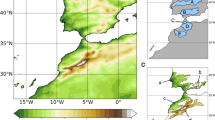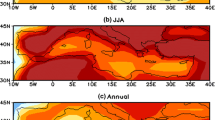Abstract
This paper reconciles the difference in the projections of the wet season over the Southeastern United States (SEUS) from a global climate model (the Community Climate System Model Version 3 [CCSM3]) and from a regional climate model (the Regional Spectral Model [RSM]) nested in the CCSM3. The CCSM3 projects a dipole in the summer precipitation anomaly: peninsular Florida dries in the future climate, and the remainder of the SEUS region becomes wetter. The RSM forced with CCSM3 projects a universal drying of the SEUS in the late twenty-first century relative to the corresponding twentieth-century summer. The CCSM3 pattern is attributed to the “upped-ante” mechanism, whereby the atmospheric boundary layer moisture required for convection increases in a warm, statically stable global tropical environment. This criterion becomes harder to meet along convective margins, which include peninsular Florida, resulting in its drying. CCSM3 also projects a southwestward expansion of the North Atlantic subtropical high that leads to further stabilizing of the atmosphere above Florida, inhibiting convection. The RSM, because of its high (10-km grid) resolution, simulates diurnal variations in summer rainfall over SEUS reasonably well. The RSM improves upon CCSM3 through the RSM’s depiction of the diurnal variance of precipitation, which according to observations accounts for up to 40 % of total seasonal precipitation variance. In the future climate, the RSM projects a significant reduction in the diurnal variability of convection. The reduction is attributed to large-scale stabilization of the atmosphere in the CCSM3 projections.











Similar content being viewed by others
References
Atkins N, Wakimoto R, Weckwerth T (1995) Observations of the sea-breeze front during CaPE. Part II: dual-doppler and aircraft analysis. Mon Wea Rev 123:944–969
Bastola S, Misra V (2013) Sensitivity of hydrological simulations of southeastern United States watersheds to temporal aggregations of rainfalls. J Hydrometeor. doi:10.1175/JHM-D-12-096.1
Biggs W, Graves M (1962) A lake breeze index. J Appl Meteor Climatol 1:474–480
Bove M, Elsner J, Landsea C, Niu X, O’Brien J (1998) Effect of El Niño on U.S. landfalling hurricanes, revisited. Bull Am Soc 79:2477–2482
Briegleb B, Bitz C, Hunke E, Lipscomb W, Holland M, Schramm J, Moritz R (2004) Scientific description of the sea ice component in the community climate system model, version three. Tech. Rep. NCAR/TN-463 + STR, 78 pp
Bukovsky M, Karoly D (2008) An evaluation of climate model precipitation over the United States, 20th conference on climate variability and change, New Orleans, LA. American Meteorological Society, P3.8
Carbone R, Tuttle J (2008) Rainfall occurrence in the U.S. warm season: the diurnal cycle. J Climate 21:4132–4146
Chan S, Misra V (2010) A diagnosis of the 1979–2005 extreme rainfall events in the Southeastern United States with isentropic moisture tracing. Mon Wea Rev 138:1172–1185
Chiang J, Sobel A (2002) Tropical tropospheric temperature variations caused by ENSO and their influences on the remote tropical climate. J Climate 15:2616–2631
Chou MD, Lee KT (1996) Parameterizations for the absorption of solar radiation by water vapor and ozone. J Atmos Sci 53:1203–1208
Chou MD, Suarez MJ (1994) An efficient thermal infrared radiation parameterization for use in general circulation models. Technical report series on global modeling and data assimilation, NASA/TM-1994-104606, 3, 85 pp
Christensen J et al (2007) Regional climate projections. Climate change 2007: the physical science basis. Cambridge University Press, Cambridge
Collins W et al (2004) Description of the NCAR community atmosphere model (CAM3). Tech. Rep. NCAR/TN-464 + STR, 226 pp
Collins W et al (2006) The community climate system model version 3 (CCSM3). J Climate 19:2122–2143
Dai A (2006) Precipitation characteristics in eighteen coupled climate models. J Climate 19:4606–4630
Dickinson R, Oleson K, Bonan G, Hoffman F, Thornton P, Vertenstein M, Yang ZL, Zeng X (2006) The community land model and its climate statistics as a component of the community climate system model. J Climate 19:2302–2324
Doblas-Reyes F, Goodess C (2005) Working paper on the need for downscaling of seasonal-to-decadal integrations within the EU-funded ENSEMBLES project. ENSEMBLES Technical Report No. 2, 10 pp. [ISSN 1752-2854]
Ek M, Mitchell K, Lin Y, Rogers E, Grunmann P, Koren V, Gayno G, Tarpley J (2003) Implementation of Noah Land surface model advances in the national centers for environmental prediction operational Mesoscale Eta Model. J Geophys Res 108:8851
Elguindi N, Grundstein A (2013) An integrated approach to assessing 21st century climate change over the contiguous US using the NARCCAP RCM output. Climatic Change 117:809–827
Hansen J, Hodges A, Jones J (1998) ENSO influences on agriculture in the southeastern United States. J Climate 11:404–411
Hong S, Pan H (1996) Nonlocal boundary layer vertical diffusion in a medium range forecast model. Mon Wea Rev 124:2322–2339
Juang HM, Kanamitsu M (1994) The NMC nested regional spectral model. Mon Wea Rev 122:3–26
Kanamaru H, Kanamitsu M (2007a) Scale-selective bias correction in a downscaling of global analysis using a regional model. Mon Wea Rev 135:334–350
Kanamaru H, Kanamitsu M (2007b) Fifty-seven-year reanalysis downscaling at 10 km (CaRD10). Part II: comparison with North American Regional Reanalysis. J Climate 20:5572–5592
Kanamitsu M, Kanamaru H (2007) Fifty-seven-year reanalysis downscaling at 10 km (CaRD10). Part I: system detail and validation with observations. J Climate 20:5553–5571
Kanamitsu M, Yoshimura K, Yhang Y (2010) Errors of interannual variability and trend in dynamical downscaling of reanalysis. J Geophys Res 115:1–17
Karl T, Melillo J, Peterson T (2009) Global climate change impacts in the United States. Cambridge University Press, Cambridge
Kushnir Y, Seager R, Ting M, Naik N, Nakamura J (2010) Mechanisms of tropical Atlantic SST influence on North American precipitation variability. J Climate 23:5610–5628
LeMone M (1973) The structure and dynamics of horizontal roll vortices in the planetary boundary layer. J Atmos Sci 30:1077–1091
Li W, Li L, Fu R, Deng L, Wang H (2011) Changes to the north Atlantic subtropical high and its role in the intensification of summer rainfall variability in the southeastern United States. J Climate 24:1499–1506
Lin Y, Mitchell K (2005) The NCEP Stage II/IV hourly precipitation analyses: development and applications. Preprints, 19th conference on hydrology, american meteorological society, San Diego, CA, 9–13 January 2005, Paper 1.2
Loveland T, Merchant J, Reed B, Brown J, Ohlen D, Olson P, Hutchinson J (1995) Seasonal land cover regions of the United States. Ann Assoc Am Geogr 85:339–355
Mearns L, Gutowski W, Jones R, Leung L, McGinnis S, Nunes A, Qian Y (2009) A regional climate change assessment program for North America. EOS 90:311–312
Misra V, DiNapoli S (2012) Understanding the wet season variations over Florida. Clim Dyn (in press). doi:10.1007/s00382-012-1382-4
Misra V, Moeller L, Stefanova L, Chan S, O’Brien JJ, SmithIII TJ, Plant N (2011) The influence of the Atlantic warm pool on the panhandle Florida Sea breeze. J Geophys Res. doi:10.1029/2010JD01
Misra V et al (2011b) Climate scenarios: a Florida-Centric view, Florida climate change task force
Neelin J, Chou C, Su H (2003) Tropical drought regions in global warming and El Nino teleconnections. Geophys Res Lett. doi:10.129/2003GLO018625
Oleson K et al (2004) Technical description of the community land model (CLM). Tech. Rep. NCAR/TN-461 + STR, 174 pp
Pan H, Wu W (1995) Implementing a mass-flux convective parameterization package for the NMC medium range forecast model, paper presented at 10th conference on Numerical Weather Prediction. American Meteorological Society, Portland, Oregon
Parker M, Ahijevych D (2007) Convective episodes in the east-central United States. Mon Wea Rev 135:3707–3727
Rauscher S, Kucharski A, Enfield D (2011) The role of regional SST warming variations in the drying of Meso-America in future climate projections. J Climate 24:2003–2016
Schwartz B, Bosart L (1979) The diurnal variability of florida rainfall. Mon Wea Rev 107:1535–1545
Seager R, Tzanova A, Nakamura J (2009) Drought in the southeastern United States: causes, variability over the last millennium, and the potential for future hydro climate change. J Climate 22:5021–5045
Slingo J (1987) The development and verification of a cloud prediction scheme for the ECMWF model. Q J R Meteorol Soc 113:899–927
Smith R, Gent P (2002) Reference manual for the parallel ocean program (POP), ocean component of the Community Climate System Model (CCSM 2.0 and 3.0) Tech. Rep. LA-UR-02-2484, Los Alamos National Laboratory
Sobolowski S, Pavelski T (2011) Evaluation of present and future North American regional climate change assessment program (NARCCAP) regional climate simulations over the southeast United States. J Geophys Res 117. doi:10.1029/2011JD016430
Stefanova L, Misra V, Chan S, Griffin M, O’Brien J, Smith T III (2012) A proxy for high-resolution regional reanalysis for the Southeast United States. Climate Dyn 38:2449–2466
Vecchi G, Clement A, Soden B (2008) Examining the tropical Pacific’s response to global warming. Trans Amer Geophys Union 89:81–83
Xie S, Deser C, Vecchi G, Ma J, Teng H, Wittenberg A (2010) Global warming pattern formation: sea surface temperature and rainfall. J Climate 23:966–986
Yualeva E, Holton J, Wallace J (1994) On the cause of annual cycle in the tropical lower stratospheric temperature. J Atmos Sci 51:169–174
Zhang DL, Zhang S, Weaver S (2006) Low-level jets over Mid-Atlantic states: warm-season climatology and a case study. J Appl Meteor Climatol 45:194–209
Zhang X, Dimarco S, Smith D, Howard M, Jochens A, Hetland R (2009) Near-resonant ocean response to sea breeze on a stratified continental shelf. J Phys Oceanogr 39:2134–2155
Acknowledgments
We acknowledge the editorial assistance of Kathy Fearon of COAPS, FSU. This study was supported by grants from NOAA (NA07OAR4310221), USDA (027865), and USGS (06HQGR0125).
Author information
Authors and Affiliations
Corresponding author
Appendix
Appendix
The surface lifted index (SFI) is a measure of atmospheric stability. It is defined as the difference between the environmental air temperature at 500 mb and the temperature a parcel of air will achieve if lifted dry adiabatically to its lifting condensation level (LCL) and then lifted moist adiabatically to 500 mb. Positive values of SFI are considered to be stable, and negative values are considered unstable.
Rights and permissions
About this article
Cite this article
Selman, C., Misra, V., Stefanova, L. et al. On the twenty-first-century wet season projections over the Southeastern United States. Reg Environ Change 13 (Suppl 1), 153–164 (2013). https://doi.org/10.1007/s10113-013-0477-8
Received:
Accepted:
Published:
Issue Date:
DOI: https://doi.org/10.1007/s10113-013-0477-8




